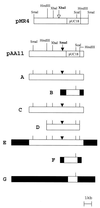Transformation of Escherichia coli with DNA from Saccharomyces cerevisiae cell lysates
- PMID: 10583980
- PMCID: PMC91720
- DOI: 10.1128/AEM.65.12.5303-5306.1999
Transformation of Escherichia coli with DNA from Saccharomyces cerevisiae cell lysates
Abstract
We developed a system to monitor the transfer of heterologous DNA from a genetically manipulated strain of Saccharomyces cerevisiae to Escherichia coli. This system is based on a yeast strain that carries multiple integrated copies of a pUC-derived plasmid. The bacterial sequences are maintained in the yeast genome by selectable markers for lactose utilization. Lysates of the yeast strain were used to transform E. coli. Transfer of DNA was measured by determining the number of ampicillin-resistant E. coli clones. Our results show that transmission of the Amp(r) gene to E. coli by genetic transformation, caused by DNA released from the yeast, occurs at a very low frequency (about 50 transformants per microg of DNA) under optimal conditions (a highly competent host strain and a highly efficient transformation procedure). These results suggest that under natural conditions, spontaneous transmission of chromosomal genes from genetically modified organisms is likely to be rare.
Figures


References
Publication types
MeSH terms
Substances
LinkOut - more resources
Full Text Sources
Molecular Biology Databases

